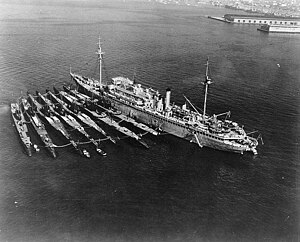
USS Tang (SS/AGSS-563), the lead ship of her class was the second ship of the United States Navy to be named for the tang.
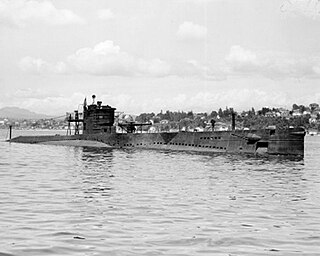
USS S-28 (SS-133) was an S-class submarine of the United States Navy. A diesel submarine, she served in World War II during which sank one Japanese ship. She was lost at sea with all hands in July 1944. Her wreck was discovered in 2017 at a depth of 8,500 feet (2,600 m) off the coast of Oahu.

USS Rainbow (AS-7) was the only ship in the United States Navy by that name. The ship was originally converted to a distilling ship in 1898, and then converted again in 1917 to a submarine tender.
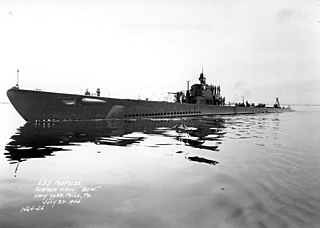
USS Porpoise (SS–172), the fifth United States Navy ship to bear her name, was the lead ship of her class of submarines.

The first USS Philip (DD–76) was a Wickes-class destroyer in the United States Navy during World War I, later transferred to the Royal Navy as HMS Lancaster. She was named for John Woodward Philip.

USS Skipjack (SS-184), was a Salmon-class submarine, the second ship of the United States Navy to be named after the skipjack tuna. She earned multiple battle stars during World War II and then was sunk, remarkably, by an atomic bomb during post-World War II testing in Operation Crossroads. Among the most "thoroughly sunk" ships, she was refloated and then sunk a second time as a target ship two years later.
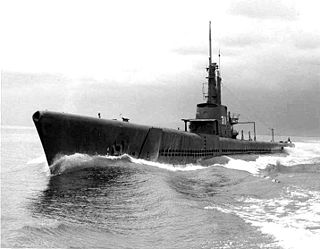
USS Archerfish (SS/AGSS-311) was a Balao-class submarine. She was the first ship of the United States Navy to be named for the archerfish. Archerfish is best known for sinking the Japanese aircraft carrier Shinano in November 1944, the largest warship ever sunk by a submarine. For this achievement, she received a Presidential Unit Citation after World War II.

USS Bashaw (SS/SSK/AGSS-241), a Gato-class submarine, was the first ship of the United States Navy to be named for the bashaw. Between 10 March 1944 and 29 April 1945, she completed six war patrols in the Celebes, Philippine, and South China Seas during World War II. Bashaw sank three Japanese merchant vessels totaling 19,269 gross register tons as well as several small craft. She later served in the Vietnam War.

USS Blackfin (SS-322), a Balao-class submarine in commission from 1944 to 1948 and from 1951 to 1972, was a ship of the United States Navy named for the blackfin cisco, a food fish of the Great Lakes.
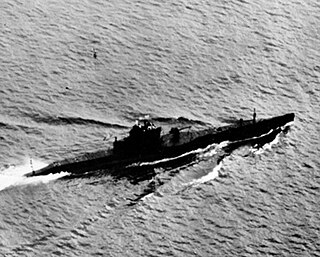
USS S-31 (SS-136) was a first-group S-class submarine of the United States Navy.

USS S-18 (SS-123) was a first-group S-class submarine of the United States Navy in commission from 1924 to 1945. She served during World War II, seeing duty primarily in the Aleutian Islands campaign.

USS Curtiss (AV-4) was the first purpose-built seaplane tender constructed for the United States Navy. She was named for Glenn Curtiss, an American naval aviation pioneer that designed the Curtiss NC-4, the first aircraft to fly across the Atlantic Ocean.

USS Wright (AZ-1/AV-1) was a one-of-a-kind auxiliary ship in the United States Navy, named for aviation pioneer Orville Wright. Originally built as a kite balloon tender, she was converted into a seaplane tender after kite balloons were no longer used.

USS Sicard (DD-346/DM-21/AG-100) was a Clemson-class destroyer in the United States Navy following World War I. She was named for Montgomery Sicard.
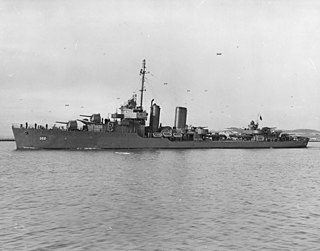
The third USS Worden (DD-352) was a Farragut-class destroyer in the United States Navy during World War II. She was named for John Lorimer Worden.

The second USS Gridley (DD-380) was the lead ship of her class of destroyers in the United States Navy. She was the second US Navy ship named for Charles Vernon Gridley. She served with distinction in the Pacific Theater during the Second World War and shared in the sinking of a Japanese submarine.

USS Sperry (AS-12) was a Fulton-class submarine tender in the United States Navy. She was named for Elmer Sperry.

USS Nereus (AS-17) was a Fulton-class submarine tender in service with the United States Navy from 1945 to 1971. She was scrapped in 2012.

USS Argonne (AP-4/AS-10/AG-31) was a Design 1024 cargo ship built under United States Shipping Board contract by the International Shipbuilding Corp., Hog Island, Pennsylvania, for the United States Department of War. Named Argonne for the U.S. Army's Meuse-Argonne campaign in World War I, she was completed in 1920, delivered to the War Department in December 1920, laid up in February 1921, and loaned to the Navy on 3 November 1921. Accepted preliminarily by the Navy on that date, she was commissioned as Argonne on 8 November 1921 at the Philadelphia Navy Yard. The ship was permanently transferred to the Navy 6 August 1924 by Executive Order.

USS Pelias (AS–14) was a Griffin-class submarine tender in service with the United States Navy from 1941 to 1970.
